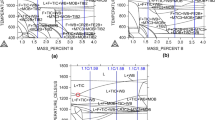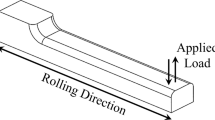Conclusions
-
1.
The extremal dependence of the critical brittleness temperature on the chromium and nickel contents in steel with consideration given to data on the effect of chromium and nickel on hardenability and nickel (for a certain phosphorus content) on temper brittleness makes it possible to select the optimum composition of Cr-Ni-Mo-V steels.
-
2.
Cr-Ni-Mo-V steels with an increased chromium content (more than 2.0%) and nickel content (more than 2.0%) are inclined to embrittlement during tempering in connection with the formation of special carbides that are segregated along the grain boundaries. Embrittlement intensifies with increasing chromium and nickel content in the steel.
-
3.
Cr-Ni-Mo-V steels are prone to embrittlement during slow cooling owing to the grain-boundary segregation of phosphorus. Embrittlement during slow cooling from the tempering temperature increases with increasing nickel content owing to intensification of the grain-boundary segregation of phosphorus.
-
4.
As compared with steel containing 1.0–1.5% Cr and 3.0–4.0% Ni, Cr-Ni-Mo-V steels with up to 2% Cr and up to 2% Ni have a lower critical brittleness temperature and adequately high hardenability, which ensures a bainite structure and a satisfactory set of mechanical properties in forgings up to 1850 mm in diameter when quenched in water, and in forgings up to 850 mm in diameter when quenched in oil.
Similar content being viewed by others
Literature Cited
A. A. Astaf'ev, G. S. Kark, and S. I. Markov, "The phosphorus peak of internal friction in pearlite steel," Fiz. Met. Metalloved.,45, 197 (1978).
L. I. Spektor, V. I. Sarrak, and R. I. Éntin, "On reasons for the effect of nickel on the coldshortness of iron," Dokl. Akad. Nauk SSSR,155, No. 5, 1054 (1964).
A. Jonhi and D. Stein, Am. Soc. Testing Mater. STP, No. 499, 59 (1972).
A. Seisik, C. Uckahon, and H. Feng, Met. Trans.,9A, No. 3, 321 (1978).
Additional information
Nongovernment Organization. Central Scientific-Research Institute of Technology and Machine Construction. Translated from Metallovedenie i Termicheskaya Obrabotka Metallov, No. 3, pp. 11–14, March, 1982.
Rights and permissions
About this article
Cite this article
Astaf'ev, A.A. The rational alloying of chromium-nickel structural steels. Met Sci Heat Treat 24, 159–161 (1982). https://doi.org/10.1007/BF01166842
Issue Date:
DOI: https://doi.org/10.1007/BF01166842




